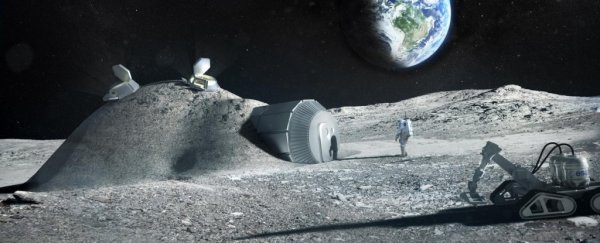If we humans want to go live on the Moon - which we are planning to do - we're going to have to have something to actually live in. Small landers may have worked for the brief duration of the Apollo missions, but for longer-term stays, we're going to need something a bit more permanent.
Since schlepping building materials to the Moon is an expensive logistical nightmare, space agencies are investigating materials that can be found in situ. And now they've realised that one of them can be found in… urine.
Specifically, the urea in astronaut wee could be used to plasticise the concrete used to build structures on the Moon, making them less brittle and more flexible, resulting in hardier buildings.
"To make the geopolymer concrete that will be used on the Moon, the idea is to use what is there: regolith (loose material from the Moon's surface) and the water from the ice present in some areas," said materials scientist Ramón Pamies of the Polytechnic University of Cartagena in Spain.
"But moreover, with this study we have seen that a waste product, such as the urine of the personnel who occupy the Moon bases, could also be used. The two main components of this body fluid are water and urea, a molecule that allows the hydrogen bonds to be broken and, therefore, reduces the viscosities of many aqueous mixtures."
Scientists here on Earth have already been conducting experiments to determine which materials could be used to build a decent Moon base.
There are several concerns that need to be taken into account. Lunar temperatures vary, from 120 degrees Celsius (250 Fahrenheit) during the day to -130°C (-208°F) at night (and even colder at the poles!), so the building material needs to be able to withstand significant thermal change, while insulating the interior.
Without an atmosphere, the Moon's surface is subject to a lot of radiation; and, without an atmosphere, there's nothing to burn up any space rocks that might want to rain down. With an estimated 44,000 kilograms (97,000 pounds) of meteoric material hitting Earth every day, there's a lot of potential bombardment a lunar structure will have to withstand.
So, since urea's properties are well known, and it can be found anywhere humans are, the research team decided to try building some small structures out of simulated lunar regolith and urea. Using a 3D printer, they constructed cylinders of the mixture to determine how well urea works as a plasticiser.
They also made cylinders from the regolith simulant and polycarboxylate- and naphthalene-based superplasticisers, and a control cylinder without any plasticiser at all. These allowed the team to compare their results, by putting the cylinders through a series of strength tests, incorporating eight freeze-thaw cycles to represent Moon-like temperature fluctuations.
The mixtures containing urea or naphthalene-based superplasticiser performed quite well as 3D printing materials - they were 'soft' enough to build up a structure without any noticeable deformation (although the naphthalene sample cracked a little in the moulding process), but were able to bear heavy loads shortly after being printed without losing shape too much.
The polycarboxylate and the control mixture, on the other hand, were too rigid to be easily moulded after casting, and developed significant stress fractures, even though they kept their shape when loaded with a small weight.
The team also tested the compressive strength of their samples after a series of freeze-thaw cycles, and found that the urea mixture exhibited a "continuous slight increase in compressive strength".
It seems like there is a lot of pee-tential in astronaut wee-bags. Further testing will be required, but it may even be possible to use the urine as it comes out, without having to separate out the urea.
"We have not yet investigated how the urea would be extracted from the urine, as we are assessing whether this would really be necessary, because perhaps its other components could also be used to form the geopolymer concrete," said materials scientist Anna-Lena Kjøniksen of Østfold University College in Norway.
"The actual water in the urine could be used for the mixture, together with that which can be obtained on the Moon, or a combination of both."
By the way, there's an entire tank of wee up there already, left behind by the Apollo astronauts. And this is certainly a better use for it than that time Buzz Aldrin peed his pants on the Moon…
The research has been published in the Journal of Cleaner Production.
